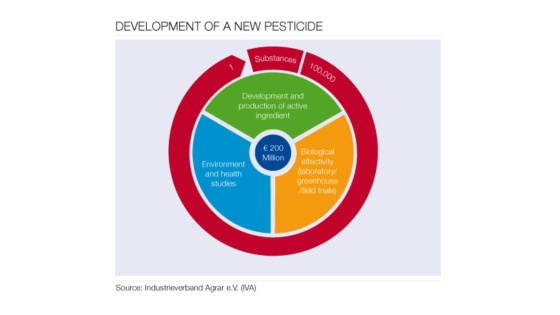Healthy crops mean safe food
Over the last forty years, scientific advances have provided consumers with a wide range of affordable, high quality food. However, the modernization of agriculture has raised new concerns amongst consumers, particularly around the use of pesticides.
For farmers, pesticides are an important tool in their overall crop management portfolio. The challenge is to deliver high volume, high quality yields at affordable prices, while simultaneously meeting the high standards demanded by both consumers and retailers.
Crop protection for high quality, high volume yields
Crops must compete with 30,000 species of weeds, 3,000 species of nematodes and 10,000 species of plant-eating insects, all of which can seriously impact harvest yield. Naturally occurring fungal diseases also threaten unprotected plants. These are not only capable of causing substantial harvest losses but crops can also be contaminated by mycotoxins, highly toxic substances, produced by the fungus itself.
Today, major crop failures or famines in countries with well-developed agricultural sectors have thankfully been confined to history. However, farmers still lose 20 to 40 percent of their annual harvest due to weeds, pests and plant diseases. Without crop protection, this figure would be twice as high.
Safety comes first
Pesticides are only authorized in the first place if an independent, expert risk assessment – undertaken under a set of unfavourable circumstances and incorporating high safety margins – consistently verifies that any residues remaining after proper use of the product are below the safety levels for consumers. In terms of usage, farmers comply with good agricultural practice, following the principle of using pesticides only when needed and then, as little as possible.

In addition to the safety standards, separate trading standards, called Maximum Residue Levels (MRLs) are also in place to check whether a pesticide has been correctly applied.
Exceeding the maximum residue levels does not usually pose a risk to health as trading standards are usually far below safety limits, which, in themselves, include wide safety margins. However, it does indicate that the pesticide has been incorrectly used. The crop protection industry views any violation of trading standards as unacceptable practice and is committed to eliminating this problem.
Understanding
As part of the BASF Farm Perspective Study, more than 1,800 farmers and 6,000 consumers form across Brazil, India, France, Germany, Spain and the U.S were interviewed. The study shows that while the majority of consumers view farming as a vocation and have great respect for famers and the work they do, they also recognize that there is a need to strengthen the environmental role that farmers currently play.
Developing
Special biological scent dispensers like the BASF pheromone dispensers are an alternative way to control pests. They have the advantage of having no physical contact with the crop but yet control grape and apple moths, which impact fruit quality and yield.
BASF spray programs combining chemistry and biology enable farmers to control pests effectively while securing food safety. While biological fungicides alone cannot control infection rates adequately, chemical fungicides, while offering sufficient control, cannot be applied shortly before harvesting period.
Initiating
In India, as part of the Samruddhi project BASF employees educate farmers about fertilization, seed rate, spacing and the appropriate use of pesticides through field demonstrations.
In 2009, BASF initiated the disease and pest management program Uvas sin fronteras ("Grapes without frontiers") to help table grape producers in Chile fulfill the strict requirements of export markets regarding residues limits.